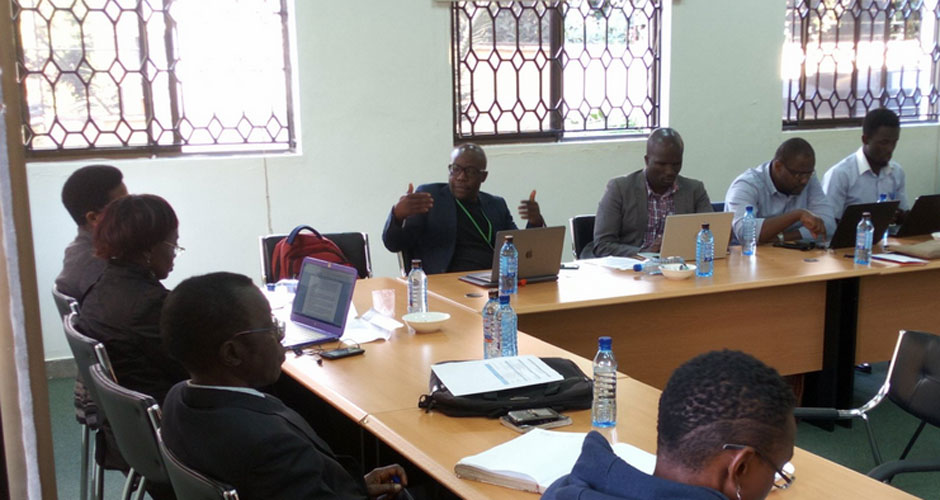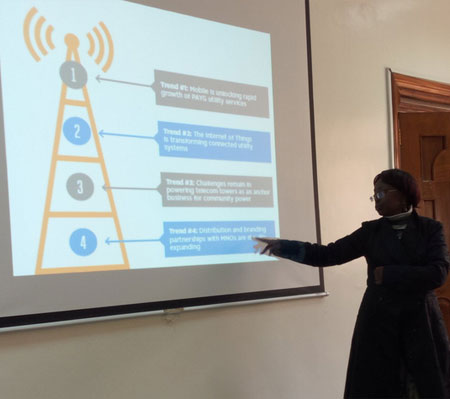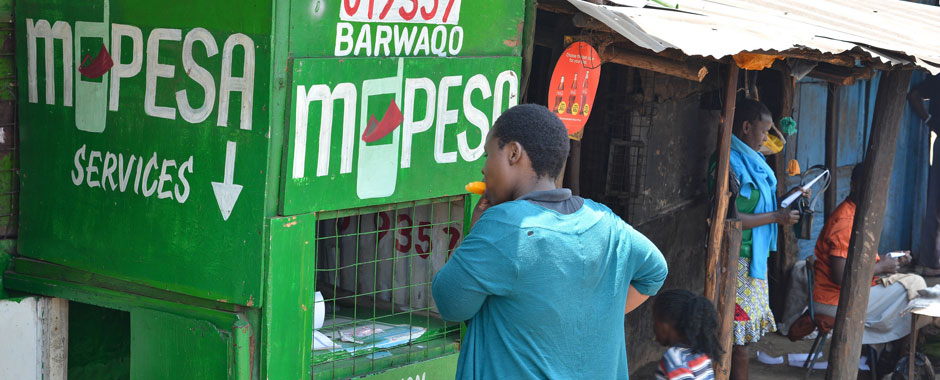by Victoria Chengo and Kennedy Mbeva, Africa Sustainability Hub
The second Transformation Lab workshop (T-Lab) organised by the Africa Sustainability Hub was held in June in Nairobi, Kenya – one of six study sites in the international Pathways Network. As part of a 3-year process, the workshop discussed what needs to be done to enable transformative and sustainable access for all, to solar energy systems via mobile-based payment systems.
It specifically explored the transformations associated with mobile enabled payment services for Solar Home Systems (SHS), M-KOPA, and how the challenges facing such transformations can be addressed based on co-learning. The participants included stakeholders from government, NGOs, civil society, private sector, development partners, research and academia.
M-KOPA (M for mobile, Kopa for credit in Swahili), is a mobile-enabled payment system for solar home systems that has operated in Kenya since 2013. As the name suggests, it utilizes a mix of technological and social features of mobile phones to enable access to credit and payment schedules for households to access the SHS.
Registration within a mobile phone network enables households to access credit facilities for purchasing solar systems for their homes. Mobile networks enable households to build networks through which they can pull resources and bargain for credits to access the SHS; and the mobile networks accelerate communication and access to information.
The credits are deployed through various payment models, for example pay-as-you-go, and hire-purchase, where poorer households can pay for the solar system in instalments over some time.

Benefits of the rapidly-expanding market IN solar home systems
In order to effectively gauge how transformative M-KOPA is, we need to view the transformation in context. It has been observed that transformation cannot be quantified by singular actors, as it is viewed differently by different people. For instance, is the transformation from the perspective of the end user, the service provider (in this case Safaricom, the giant telecommunications company in Kenya on whose M-PESA platform, the M-KOPA is hinged) or the users of the SHS?
Transformation from the end user’s perspective
The key features of a transformative SHS that emerged from our project are that they should be cost-effective, responsive to consumer needs, easily accessible, reliable, accountable, and life-changing. This could be true of MKOPA, if the benefits enumerated below are anything to go by.
Direct benefits include access to lighting and clean energy by consumers not connected to the grid, especially in rural areas and informal settlements. Apart from these, other indirect benefits could be measured in terms of reduced respiratory diseases previously acquired through continued use of kerosene lamps, and more study time by school-going children, thus enhancing their academic performance. Money which would otherwise be regularly spent on purchasing kerosene can be used in taking care of other equally important household expenditures or savings for a rainy day. However, there have been concerns with low quality of some solar home systems, which may be prone to failure or have a shorter shelf life; and also their cost-effectiveness over prolonged payment periods. This is discussed further below, under constraints of the M-KOPA.
Transformation from the vendors’ perspective
Transformations to the vendors and stockists of SHSs are expressed in terms of the creation of employment opportunities and a means of livelihood. More disposable income means they can save money and improve their living standards.
Transformation from the service provider’s perspective
M-KOPA views transformation in terms of the jobs created and, in general, lives impacted by access to energy among rural people and those in informal settlements, the bulk of which are not connected to the national grid.

With the Pay As You Go (PAYG) scheme, customers are able to affordably pay daily instalments and get to own the SHS once the last instalment is paid. The PAYG has however had its share of criticism, with its impact being questioned. One might ask if it is the best model compared to, for instance, lowering the overall price of the SHS? Do PAYG schemes simply deplete revenues/reduce disposable income? The current system could be improved by an evaluation of the PAYG framework. Is it more cost-effective to post-pay or pre-pay for electricity services? Evidence based research should be able to inform this.
Factors hindering full transformation and how to overcome them
Though transformation has been reported across the three levels (end user, vendor and service provider), there are a few factors that still hamper the optimal transformation of M-KOPA.
Lack of reliable data based on actual research
Available data on MKOPA is either outdated or one-sided. Efforts are needed in collating quality and reliable data especially through county offices. Research should also be conducted at household level on the type of issues the community wants addressed or taken into account within the SHS. Data could also be obtained from players in the market (vendors and service providers). To ensure consistency, research could be carried out periodically to take account of changes and trends in SHS.
An intergovernmental approach, whereby counties build a database to monitor and evaluate the e-waste from solar power and regulate off-grid systems was also proposed in our workshop.
This data would be useful in mapping geographical areas that lack connection to the grid that pay-as-you-go models could target.
Dependence on strength of network signal
There are concerns the M-KOPA initiative is only viable in areas where Safaricom signal is strong/reliable. This limits the uptake of the product. More boosters should be erected in remote/affected areas.
Inadequate awareness of the SHS
There is inadequate information on the existence and benefits of M-KOPA. A number of strategies could address this:
- There should be a personal intervention on occasional basis to help consumers better understand the system, and to address any queries. This could be through media, especially vernacular stations which reach the remotest of areas. Roadshows could also be particularly useful, especially on market days.
- County organized field days for MKOPA to interact with community groups and provides list of Chamas (community saving groups) or Saccos (Savings and Credit Cooperative Organizations) within counties for MKOPA to interact with/sell to. This should be intensified and areas of coverage widened.
- It is also recommended that community champions trusted by communities help create awareness on SHS space, and perform any function relevant to capturing perceptions from the community.
- Academic institutions should be involved as they are key in driving capacities and building linkages. Knowledge sharing between institutions on how the quality of the SHS can be improved should also be encouraged.
- Network building amongst consumers of mobile-enabled SHS where end users share values on best experiences/ intellectual property could be useful in creating awareness on M-KOPA.
- Public participation is currently not being carried out properly, despite providing an avenue for innovators to interact with potential users and also an opportunity to monitor and evaluate the product use. Such can lead to product improvement and building technical capacity for local people about the product.
- Lastly, the proposed County Energy Access Platform to be hosted under the Africa Sustainability Hub (ASH) at ACTS will be key to providing reliable information and knowledge transfer.
High costs of SHS
The high cost of SHS could be lowered by increasing competition amongst distributors. Other cost-lowering measures could include simplifying the supply value chain and eliminating middlemen who have increased SHS space costs. Improving the reliability of mobile-enabled SHS will create further demand.
Low capacity of end users
The end users have limited knowledge on the operation and maintenance of the MKOPA SHS. This impacts negatively on the longevity of the product. Once word goes out that the SHS doesn’t last, people will stop buying the product. The consumers’ capacity on the product should be built so that they understand what is required of them in relation to the usage and maintenance of the system.
‘Toll-phobia’
Some consumers have developed fear for the toll numbers attached in the SHS, with claims that the toll numbers consume a lot of airtime, should they channel any queries through it. This lowers the trust of the consumers in the SHS space.
Quality of the SHS
Some end users have reported that the SHS are of an inferior quality. Some have not undergone quality testing, and a number of those that have undergone the testing have still proved to be of poor quality and faulty.
Centres for testing solar systems, aside from Kenya Bureau of Standards should be established. This will help ascertain the quality and impact of the product. Technical learning institutions with relevant energy facilities, e.g. Strathmore University, should also be engaged in testing the systems. Monitoring and evaluation of the SHS (from import to end-use) would be useful in ensuring quality of the products.
Small size of TV screens
The small size of the TV monitor that forms part of the SHS has slowed down its uptake, since customers prefer large screens. Having a larger screen may however have cost implications. It should be established if the customers would be willing to pay higher costs if bigger screens were to be part of the SHS.
Slow clearance of SHS
Further transformation opportunities can be experienced if Customs/Import clearance of MKOPA products is expedited. The clearance is unnecessarily long. It raises the question of what specifically is the problem. Could be it be that Kenya Revenue Authority is understaffed? Is itemizing the products too complicated? Answering these questions would unravel this clearance conundrum.
Policy and legislation gaps
Of the available renewable energy legislations and policies relevant to solar PVs i.e. Draft National Energy and Petroleum Policy, 2015, Renewable Energy Feed In Tariff 2012; Net metering (still in discussion and most relevant/beneficial to private sector), Mini-grid guidelines 2017, land-use policy (relevant in terms of community mini-grid installation), there is none that specifically mentions the SHS technology. However, the Energy Act of 2012 mentions small and medium systems where SHS falls under the small solar systems. The Kenya policy framework does not explicitly address the PAYG business model.
The gaps in policy and legislation should be sealed. There is need for policies/legal frameworks that will serve the following purposes:
- Protect consumers from poor quality products. Inspection of equipment being imported will be key, as all these technologies are imported. Development of standards will be the most ideal point to start.
- VAT on solar products. It is not clear what solar equipment component qualifies for the exemption. The exemption encourages the import of whole products while there is assembly in Kenya. The exemption leads to different treatment of different products, imported by various private companies. There is need to define more clearly what qualifies as solar product under the VAT exemption.
- Encourage and promote local design. If the design has to be international, it should take into account the culture and way of life of the relevant state that seeks to address or embrace the innovation.
Even as lobbying takes place for the right policies to be put in place, implementation of existing policies should be improved upon, rather than creating new policies. Transformation should be achieved by what is currently in play.
Existing socio-technical innovations for transforming the mobile-enabled SHS space
M-PESA remains the key innovation behind the transformative mobile-enabled SHS space, as it is the platform upon which M-KOPA operates. M-PESA is known to serve more than the purpose of sending and receiving money, as customers also use it to save money. This means M-PESA will be there for the long haul. A review of the PAYG framework could improve M-KOPA’s effectiveness.
However, opportunities exist that could boost socio-technical innovations – such as establishing competitive products and markets for SHS, and linking them to specific economic needs; supported local manufacturing and assembly; and also capacity building for creating linkages and sharing of intellectual property through existing institutional frameworks.
Emerging innovative governance approaches in support of mobile-enabled SHS
At the county level, there is no policy that provides entry to PAYG solar service companies. However, there are various initiatives that have supported the distribution of SHS e.g. the County Integrated Development Plans (CIDPs) and the Sustainable Energy for All (SE4ALL) initiative. M-KOPA, in dealing with end users, does not necessarily focus on national policies, but more about convincing the users how switching fuel is beneficial on an individual level. This should be changed.
There is some support for off-grid systems, however. The National Government of Kenya was noted to have established two programmes, with support from the World Bank, that were taking into account off-grid systems in a bid to increase access to energy services in underserved counties: the Kenya Off-grid Solar Access Project (KOSAP) whose objective is to support the use of solar technology to drive electrification of households; and the Kenya Electricity Modernization Project (KEMP) whose objectives are to increase access to electricity, to improve reliability of electricity service, and to strengthen Kenya Power & Lighting Company’s (KPLC) financial situation.
The proposed County Energy Access Platform which is to be coordinated in collaboration with the SE4ALL initiative was also seen as a great approach for supporting capacity building on energy governance, skill development, and knowledge transfer within counties.
Conclusion
While it has been argued that M-KOPA has been transformative, more data and time is needed to inform the extent of this transformation. The data should reflect changes in income and increased academic performance, among other parameters. To minimise biases, the research should be conducted by independent firms and obtained from a range of sources. The government should also have an increased role in gathering data on use and impacts of mobile-enabled Solar Home Systems.
Formulation and faithful implementation of relevant policies and sufficient creation of awareness of SHS remain major keys to unlock the transformation of M-KOPA. Going forward, there should be a sustained engagement with the government to realize the full potential of MKOPA to transform lives, by removing bottlenecks that hinder the uptake of solar home systems in Kenya.
This article was first posted on the Africa Sustainability Hub blog.
Victoria Chengo & Kennedy Mbeva work on the Kenya hub of the Pathways Network, which uses Transformation Labs to address social-ecological problems in six sites around the world. He is also a co-convenor of the Network.

This article is an informative and exhaustive summary of the development of solar home systems. It is interesting to see the development of mobile money (and consequently pay-as-you-go enabled SHS units) in the past decade in East Africa versus the rest of the continent. At Upya.io, we have pioneered a CRM software that lets distributors, local SMEs and social enterprises provide, monitor and finance solar units on a PAYG basis. Our most recent pilot takes us to Kenya, where we are currently working with a local social enterprise to provide dozens of units to families in rural Kenya. Keep up with our progress on our website!